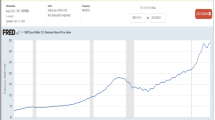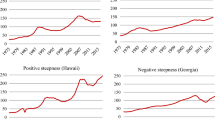Abstract
This paper develops and tests a theoretical model for residential housing market cyclical dynamics. The model employs an interactive supply and demand framework to engender housing price dynamics. Under our set of assumptions, the two equation system is econometrically identified: the first equation, housing demand, relates rent, property values, and capitalization rates with demand fundamentals. The second equation, housing supply, relates housing investment and property values with supply fundamentals. Using the model, we analyze empirically the cyclical dynamics for residential properties in Los Angeles, San Francisco, San Diego and Sacramento for the 1988–2003 time period. The theoretical and econometric design represents improvements and/or modifications of previous studies in at least four ways. First, many of the earlier commercial cyclical analyses have focused on office appraisal and have relied on sparse transactions data, which are likely to be less reliable than the copious amount of residential transactions data. Second, the cyclical volatility and timing of single-family housing is different than that of commercial real estate. Third, by examining different local MSA markets in California, our study distinguishes and isolates national-macro, regional and local market variable effects upon cycles. Finally, utilizing quarterly data (versus annual data) sharpens our ability to focus upon cyclical behaviour. Our empirical analyses suggest that fundamentals, such as employment growth and interest rates are key determinants of the residential real estate cycles. However, in general, local fundamentals tend to have greater cyclical impacts than those of national or regional fundamentals.



Similar content being viewed by others
Notes
Rents are specified in rental contracts that may be affected by exogenous demand shocks. The existence of rental contracts complicates the transmission mechanism of demand shocks on rents. Demand shocks affect the terms of contract only when tenants and landlords renegotiate; hence an exogenous demand shock may not have an immediate impact on market equilibrium rent level because of this lock-in effect. Econometrically, the assumption of a lag avoids the possible problem that rent and exogenous market factors are causally linked bilaterally.
Though our model does not explicitly incorporate the effect of vacancy on rents, it is implicitly assumed that rent and vacancy rates are correlated and the relationship is stable. In some markets where vacancy adjustment is volatile, ignoring vacancy rate dynamics may create serious problems in explaining property cycles for markets. However, since the empirical analysis in this study focuses on single-family residence market where observed vacancy rates are small and stable, our assumption is plausible.
The innovation in Topel and Rosen’s model is to include changes in investment level as one of the cost factors for housing construction. The reasoning is based on the assumption that rapid changes in the level of construction activity are penalized by higher adjustment costs.
For example, an increase in construction costs will reduce the profitability of builders and reduce housing investment. Similarly, a credit crunch will limit the ability of builders to raise capital and will reduce housing investment.
Since investment is only a small fraction of the existing stock, any new unit in the market will have little impact on price and can be sold at the current market price.
Land prices are not included explicitly in our model because the contribution of technology and costs of bricks and mortar (materials) tend to be inflexible in the short-run; hence land values tend to be the determining factor of property value changes. In such circumstances, housing values, though not perfectly correlated, tend to reflect changes in the land value. Thus the effect of land price changes is indirectly featured in the supply equation through property value. We thank an anonymous referee for identifying the issues surrounding land price changes in our model.
Since many macro-data series are non-stationary, some earlier studies try to purge the non-stationary by differencing. However, this may entail losing valuable information contained in the level variables. In this study, we choose to use level variables and to address non-stationarity problems by detrending some of the variables. Nonetheless, in the next section, empirical results are provided for alternative econometric specifications using differenced dependent variables.
Wheaton et al. (2001) develop a model that explains that current observed capitalization rates as a function of interest rates, inflation rates, lagged capitalization rates and a set of rent measures.
The necessary condition for identifiability is the order condition. One version of the order condition requires “the number of predetermined variables excluded from the equation must be at least as great as the number of included endogenous variables less 1.”(Johnston and DiNardo (1997), p.312).
The NREI Rent index is calculated, at the M.S.A. level, using data of both asking and effective rents as well as the percentage of concessions offered on the apartment properties market.
This may introduce an upward bias for capitalization rates since the single-family housing market is generally less volatile than the apartment market.
The OFHEO House Price Index is understood to have potential housing quality control issues.
Gordon et al. (1996) find that expected and unexpected employment growth have opposite effects on vacancy volatility; hence it is also possible that these two variables may also exert different impacts on rents.
See Mayer and Somerville (1996) for a discussion of the relationship between prime rate and housing construction.
The inclusion of the housing financial system is beyond the purview of our current modeling, but could represent a potentially interesting and important extension of our analysis.
References
Abraham, J. M., & Hendershott, P. H. (1996). Bubbles in Metropolitan housing markets. Journal of Housing Research, 7(2), 191–207.
Baum, A. (1999). Evidence of cycles in european commercial real estate markets—and some hypotheses. A global perspective on real estate cycles (pp. 103–114). New York: NYU Press.
Capozza, D. R., Hendershott, P. H., Mack, C., & Mayer, C. J. (2002). Determinants of real house price dynamics. NBER Working Paper Series, no. 9262.
Case, K. E., & Mayer, C. J. (1995). The housing cycle in Eastern Massachusetts: Variations among cities and towns. New England Economic Review, pp. 24–40 (March/April).
Chinloy, P. (1996). Real estate cycles and empirical evidence. Journal of Housing Research, 7, 173–190.
Clapp, J. M., & Giaccotto, C. (1994). The influence of economic variables on local house price dynamics. Journal of Urban Economics, 36, 161–183.
DiPasquale, D., & Wheaton, W. C. (1994). Housing market dynamics and the future of housing prices. Journal of Urban Economics, 35, 1–27.
Dokko, Y., Edelstein, R. H., Lacayo, A. J., & Lee, D. C. (1999). Real estate income and value cycles: A model of market dynamics. Fisher Center for Real Estate and Urban Economics Working Paper Series, no. 99–265.
Gordon, J., Mosbaugh, P., & Canter, T. (1996). Integrating regional economic indicators with the real estate cycle. Journal of Real Estate Research, 12(3), 469–501.
Green, R. K. (1997). Follow the leader: How changes in residential and non-residential investment predict changes in GDP. Real Estate Economics, 25(2), 253–270.
Grenadier, S. R. (1995). Local and national determinants of office vacancies. Journal of Urban Economics, 37, 57–71.
Grenadier, S. R. (1996). The strategic exercise of options: Development cascades and overbuilding in real estate markets. Journal of Finance, 51(5), 1653–1679 (Dec.).
Johnston, J., & DiNardo, J. (1997). Econometric methods. New York: McGraw–Hill.
Kaiser, R. W. (1997). The long cycle in real estate. Journal of Real Estate Research, 14(3), 233–257.
Mayer, C. J., & Somerville, C. T. (1996). Regional housing supply and credit constraints. New England Economic Review, pp. 39–51 (November/December).
Meese, R., & Wallace, N. (1994). Testing the present value relation for housing prices: Should I leave my house in San Francisco? Journal of Urban Economics, 35, 245–266.
Muellbauer, J., & Murphy, A. (1997). Booms and busts in the UK housing market. The Economic Journal, 107, 1701–1727 (November).
Poterba, J. M. (1991). House price dynamics: The role of tax policy and demography. Brookings Papers on Economic Activity, 1991(2), 143–203.
Phyrr, S. A., & Born, W. L. (1994). Real estate valuation: The effect of market and property cycles. The Journal of Real Estate Research, 9(4), 455–486 (Fall).
Quigley, J. M. (1999). Real estate prices and economic cycles. International Real Estate Review, 2(1), 1–20.
Rosen, K. (1984). Toward a model of the office building sector. Fisher Center for Real Estate and Urban Economics Working Paper Series, no. 84–81.
Rosen, K., & Shragowitz, R. (1985). The proposed growth limit on commercial construction for san francisco. Fisher Center for Real Estate and Urban Economics Working Paper Series, no. 85–94.
Rosen, K., & Smith, L. B. (1983). The price adjustment process for rental housing and the natural vacancy rate. The American Economic Review, 73(4), 779–786 (September).
Seko, M. (2003). Housing prices and economic cycles: Evidence from Japanese prefectures. Macro-Housing Workshop at Chinese University of Hong Kong.
Sivitanides, P. S. (1997). The rent adjustment process and the structural vacancy rate in the commercial real estate market. Journal of Real Estate Research, 13(2), 195–209.
Sivitanides, P., Southard, J., Torto, R. G., & Wheaton, W. C. (2001). The determinant of appraisal-based capitalization rates. http://www.tortowheatonresearch.com.
Topel, R., & Rosen, S. (1988). Housing investment in the United States. The Journal of Political Economy, 96(4), 718–740 (August).
Wheaton, W. C. (1987). The cyclic behavior of the national office market. AREUEA Joural, 15(4), 281–299.
Wheaton, W. C. (1999). Real estate cycles: Some fundamentals. Real Estate Economics, 27(2), 209–230.
Wheaton, W. C., & Torto, R. G. (1988). Vacancy rates and the future of office rents. AREUEA Journal, 16(4), 430–436.
Author information
Authors and Affiliations
Corresponding author
Additional information
This paper has benefited from comments by, and suggestions from seminar participants at the Hong Kong–Singapore Real Estate Research Symposium 2006 and workshop participants at the University of California at Berkeley, as well as Referee reviewers for the Journal. We acknowledge the financial support of the Fisher Center of Real Estate and Urban Economics. Errors of commission or omission remain our own.
Rights and permissions
About this article
Cite this article
Edelstein, R.H., Tsang, D. Dynamic Residential Housing Cycles Analysis. J Real Estate Finan Econ 35, 295–313 (2007). https://doi.org/10.1007/s11146-007-9042-x
Published:
Issue Date:
DOI: https://doi.org/10.1007/s11146-007-9042-x




